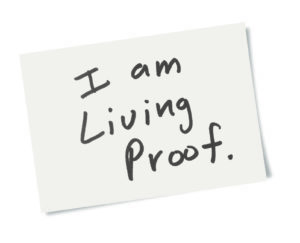At the National Storytelling Network, our mission is to advance all forms of storytelling within the community through promotion, advocacy, and education.
STORY NOW! Interview Series
The theme of our 2019 annual conference was Story Now!
Now! From the boardroom to the classroom, and the page to the stage, personal stories and folktales are catalysts for change in every aspect of our lives.
Now! We are witnessing the power of stories to tear down the walls that divide us, build bridges between people and cultures, and connect us, human-to-human. In this interview series, we’ll talk to storytellers who exemplify this Story Now! movement.
Each month we’ll sit down with an NSN member or member organization, from around the globe, and go behind the scenes to explore how they are personally harnessing the power of storytelling to tear down walls, to be a catalyst for change and connect us human-to-human. Through one-on-one, in-depth conversations, we’ll discover the type of storytelling they do, how they do it, who their audience is and, most important, they’ll give examples of the real world, tangible results they get.
 Kathy Greenamyre is NSN’s Community Relations Manager. She will be conducting interviews and contributing content each month for our Story Now! Interview Series. Kathy is the owner of a video production company. She’s interviewed hundreds of people over the past 12+ years. Her passion is to discover the world (and maybe even learn how to fix it) through listening to, recording and spreading personal stories.
Kathy Greenamyre is NSN’s Community Relations Manager. She will be conducting interviews and contributing content each month for our Story Now! Interview Series. Kathy is the owner of a video production company. She’s interviewed hundreds of people over the past 12+ years. Her passion is to discover the world (and maybe even learn how to fix it) through listening to, recording and spreading personal stories.
Living Proof Advocacy
Cofounders: Tim Cage, New York, New York, and John Capecci, Minneapolis, Minnesota
Kathy Greenamyre: In a sentence or two tell us what Living Proof Advocacy is.
John Capecci: We help purpose-driven organizations tap the power of personal stories to advocate for change. We provide coaching, workshops and consulting services, and we certify others in our coaching methods.
KG: How did you two meet? Tell us a bit about your origin story.
Tim Cage: We met in a grad school program at The University of North Carolina at Chapel Hill where we were studying communication studies, performance studies and literature in the Department of Communications. Both of us were particularly drawn to the subject of how stories “work,” whether spoken or written.
John: I was into narrative theory, adapting stories for the stage, as well as public communication…
Tim: I studied ekphrastic poetry – poetry about art or in response to art – along with interpersonal communication, and business and professional communication.
John: A nice interdisciplinary mix that pretty much points to what we’re doing now.
Tim: After we graduated, I worked at a presentation skills training company, preparing people for high-profile communications, then moved into public relations and public affairs before launching my own communication training business in New York. John went on for his Ph.D. in performance studies, became a college 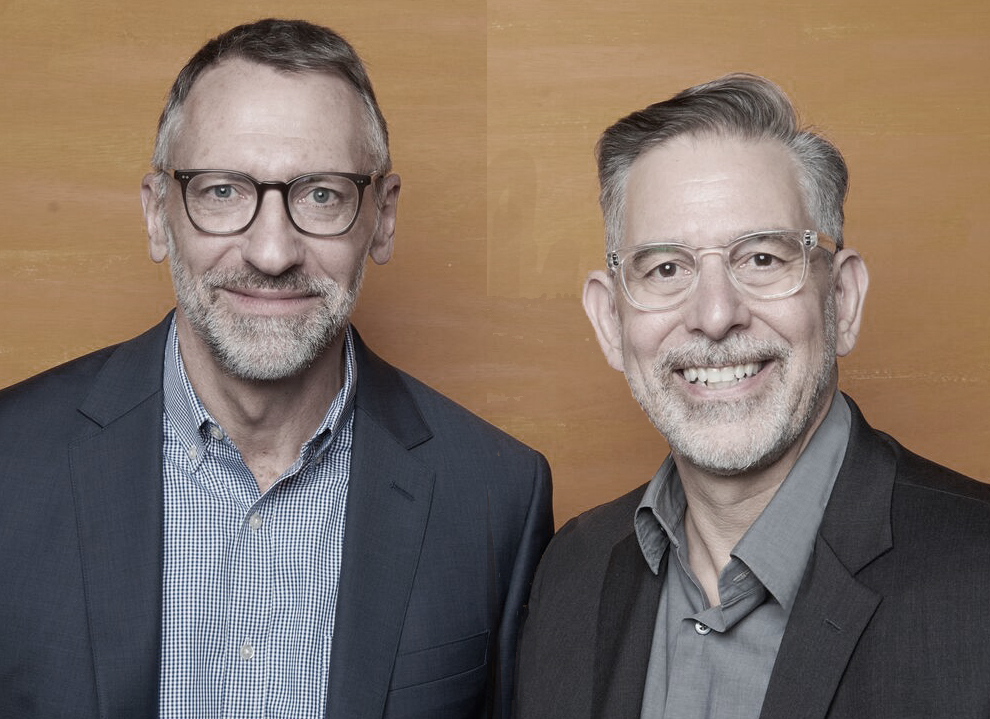 professor in a communication and theatre arts department, then left academe to launch his own consultancy in Minneapolis.
professor in a communication and theatre arts department, then left academe to launch his own consultancy in Minneapolis.
John: For a number of years, we worked independently – but took every opportunity to team up –
Tim: – to “recapture the rapture” of grad school –
John: – and to provide presentation skills and media training for a wide range of clients…which often involved helping people share their personal stories.
KG: John, you said there was a person who contacted you, about 20 years ago, and who went on to become a very important client, and a turning point for your business. Tell that story.
John: More than 20 years ago, we were contacted by Nancy Loving. Nancy was one of three women, all of whom had some form of heart disease, who were starting a new nonprofit called WomenHeart: The National Coalition for Women with Heart Disease. (Here’s a blog post about their founding and LPA’s work with them. https://www.livingproofadvocacy.com/blog/2019/9/15/womenheart-a-team-of-champions-twenty-years-in-the-making) Nancy was looking for help preparing women with heart disease to share their lived experiences in talks and in the media. She said to us: “I don’t want just some typical speaker training. We need these women to tell their stories powerfully. We need to get their stories out there and we need to save lives.” We totally got it.
Tim: This was an opportunity for us to put more of our passions into practice. We had been applying our backgrounds in communication and storytelling and rhetoric and public relations in lots of different ways, but this gave us the chance to work in this very specific context… using personal storytelling to create change.
John: And we believed – and our education and experiences had taught us – that this required a very specific approach. That’s when we started developing Living Proof Advocacy.
Sidenote: we’ve now helped WomenHeart train more than 900 women with heart disease on how to tell their stories to raise awareness, advocate for more research and educate…check them out: womenheart.org.
Tim: Fast forward a few years and two things happened. First, we realized we wanted to do more of this. It’s incredibly rewarding to support people who’ve made the choice to make a difference by telling their personal stories publicly, and to support organizations that are working to make the world better – healthier, safer, more just. Second, the more organizations we worked with, the more we realized that there was a real need for this kind of assistance – training and support that was “more than speaker training,” but also “more than a storytelling workshop.”
KG: Can you give us an example or case study that would illustrate this realization you had come to?
John: Quick example: Some years ago, we had just finished conducting a workshop for nonprofit leaders and a woman approached us and plopped a thick hardcover book onto a nearby table. It was Robert McKee’s classic Story: Substance, Structure, Style and the Principles of Screenwriting. She said, “Someone told me I should read this if our organization wanted to help people tell their stories with impact. But we’re not writing screenplays; we’re raising awareness in the community and we’re trying to influence legislators with stories of real, lived experience. Plus, the book is 500 pages long!” We heard from other organizational leaders, too, how they were having trouble finding just the right help they needed. In a lot of ways, it’s still true today: there are lots of resources for how to tell a story, or how to give a great talk, or how to be a powerful change agent… but there was nothing that pulled it all together in a way that aimed right at this application of personal storytelling for change. So, that’s about the time we decided to write Living Proof: Telling Your Story to Make a Difference,” which covers the basics of our approach and is now in its 3rd edition.
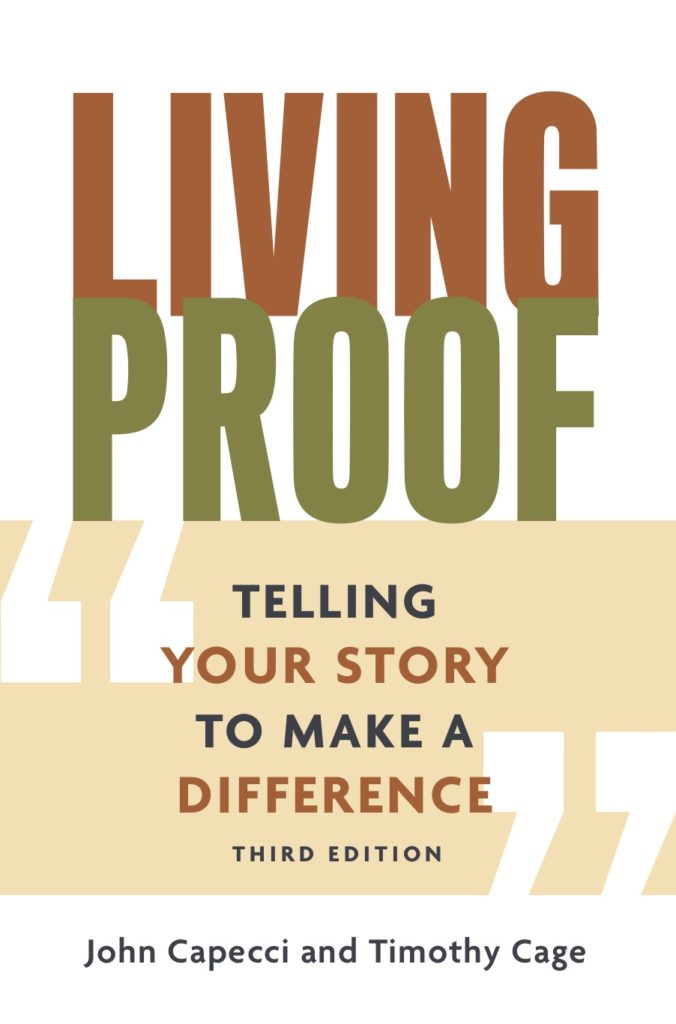
KG: We’ll dive more into the book in a minute, but tell us more about your clients and the type of people you work with and help.
Tim: The work runs the gamut. Much of it is in the health and wellness arena: organizations who rely on people to share their stories of living with a disease or condition in order to raise awareness or reduce health risks or stigma, or urge fundraising and research. Heart disease, cancers, rare diseases like myositis, and a range of mental health conditions. But it’s also groups working on other major issues: health care costs, issues impacting elders, opioid addiction, road safety, domestic violence, sustainable agriculture, homelessness…
The advocates we coach are telling their stories in their communities or speaking with legislators or interacting with the media…the situations vary greatly. Some are high-profile spokespersons; most are “everyday advocates.”
John: Typically, we work through parent organizations – advocacy groups, nonprofits, mission-driven businesses, PR agencies, community organizations – to offer training to their advocates or to help them figure out the best way to prepare advocates for success. That might be a series of workshops we provide, or consulting services to help them build a speakers’ bureau and develop curriculum or – as of about three years ago – certifying their staff in our coaching methods and approaches. That’s been really exciting.
KG: Who is Living Proof Advocacy for and who is it not for?
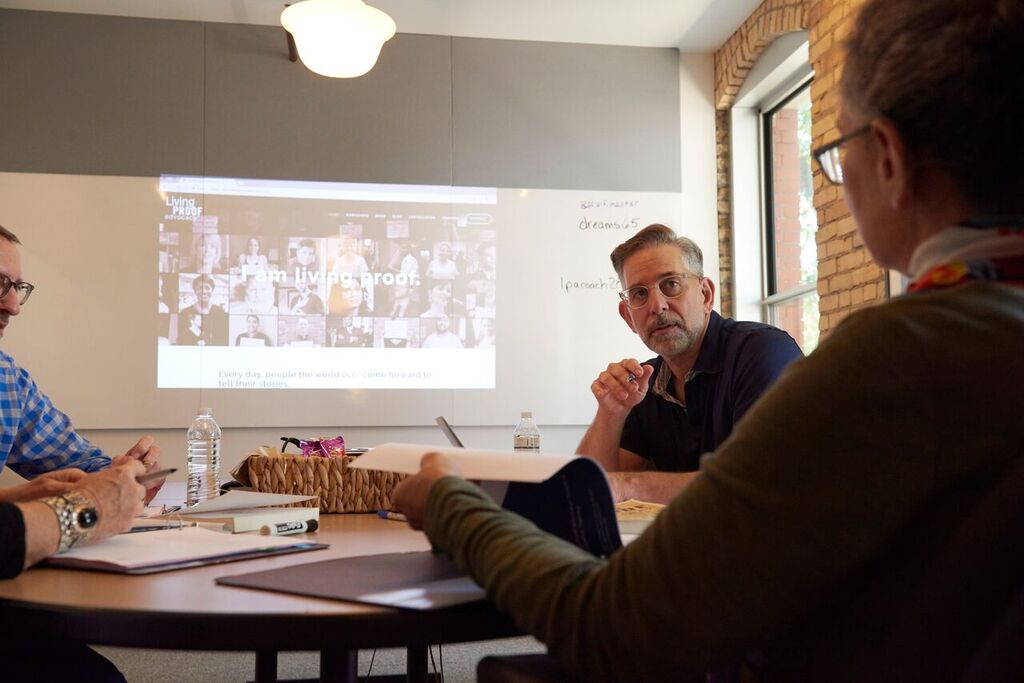 John: That’s a really interesting question and I wonder if the story practitioners out there find they have to be as intentional about this as we do. We find it’s both the blessing and the challenge of living in this “golden age of storytelling.” With so many practitioners and businesses and programs out there who are using “story” in either a very general sense or in a very specific way – stories to entertain, to heal, to build and brand a business or to develop leadership skills…the list goes on – we’ve found we need to be very clear that our focus is on the individual who’s sharing stories from their lived experience in order to create change and make the world better for others. And we focus on speaking stories, face-to-face (or face-to-media)…as opposed to writing or tweeting or telling them visually.
John: That’s a really interesting question and I wonder if the story practitioners out there find they have to be as intentional about this as we do. We find it’s both the blessing and the challenge of living in this “golden age of storytelling.” With so many practitioners and businesses and programs out there who are using “story” in either a very general sense or in a very specific way – stories to entertain, to heal, to build and brand a business or to develop leadership skills…the list goes on – we’ve found we need to be very clear that our focus is on the individual who’s sharing stories from their lived experience in order to create change and make the world better for others. And we focus on speaking stories, face-to-face (or face-to-media)…as opposed to writing or tweeting or telling them visually.
KG: You mentioned that you found no really good guides for doing this kind of work. So how did you eventually figure it out? Was it a lot of trial and error? Please give examples of some of the obstacles you faced in the beginning, and perhaps still do.
Tim: From the very start, we based the Living Proof Advocacy approach on what we call “The Five Qualities of the Well-Told Advocacy Story.” We’re constantly testing those qualities out and evolving them as necessary.
John: For example, when we started out, we called them “The Five Qualities of the Effective Advocacy Story” vs. the “Well-Told Advocacy Story.” Subtle 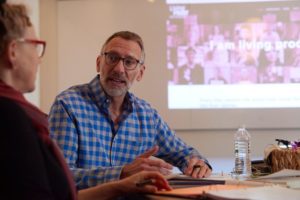 difference, but an important one.
difference, but an important one.
Tim: Right. Because one of the things we stress in our work is that this is not about learning how to craft the best kind of story. It’s about learning how to tell stories from your lived experience well…using storytelling principles but also the principles of persuasion and rhetoric. So, yes, it has been plenty of trials, with many adjustments, and it always will be – because we’re constantly asking ourselves two things: Are we basing our coaching in best practices and research? And is what we’re giving people accessible and applicable? That’s the balance we try to strike: grounded in research – like how stories help change behavior – but super simple and immediately useful to any person who wants to engage listeners in their personal story.
John: Because in the end, this kind of storytelling is judged by whether it is truly helping to make a difference, having an impact. So, that has to be our North Star.
Tim: Says the guy from The North Star State.
John: Thank you for catching that.
KG: How do you get the word out about LPA / market LPA? After 20 years, is it mainly word of mouth or other methods?
Tim: Yes, a lot is word of mouth and networking. A lot is through social media as well as our website and blog at livingproofadvocacy.com. Of course, it helps having the book out there. It still delights us to no end when we learn how far the book reaches. Getting a call or email from, say, a college instructor near Seattle who’s using the book to train midwives and doulas on how to advocate for their work, or the mental health advocate in Alaska who had the book handed to her at a conference.
John: Or the farming advocacy groups in Iowa and Canada, or the woman in Australia whose organization helps folks recover from gambling addictions…
KG: Ok, back to your fantastic book! Who’s the book for? Talk about some of the Advocate Stories that you feature.
John: Sure. The book is really a one-stop-shop for anyone who wants to share their story but may be wondering where to start and how to do it effectively. It takes you through the steps to find, focus and craft your stories, then put together a powerful advocacy talk or media interview – with lots of exercises and tips and stories.
Tim: The advocate stories in the book come from the work we’ve been so fortunate to do and the incredible advocates we’ve met. They also come from advocates who’ve impressed us with their work and who we’ve seen online or in print, and then contacted and interviewed about their process and journey.
John: There’s Dina Piersawl, one of the WomenHeart Champions who, after going through the first day of our workshop was so fired up and determined, that she announced to everyone that she was going to be on The Oprah Winfrey Show – though she didn’t really know how that was going to happen. (But it did. That’s a great story in itself.)
Tim: There’s Jacob Smith, who was in a horrible crash caused by a distracted driver; Jacob shares some really wise insights about how, after going out and telling his story a number of times, he came to feel that he “was more than the crash.” That’s a realization a lot of advocates reach, especially after they are invited repeatedly to “tell what happened.” Rape-victim advocate Natasha Alexenko makes that same point in the book: advocates want to share their stories, but it’s not just for the sharing – and it’s certainly not for pity or for their own celebrity. They have expertise, they have complex experiences, they want to move people from apathy to empathy to action. That’s what we try to help them do.
John: There’s Zach Wahls, who was in college when the video of his speech to the Iowa legislature about marriage equality went viral; now he’s an Iowa state senator. There’s Theresa Greenleaf, the mom of a son with severe allergies; Sachit Gali, a high schooler working for a tobacco-free world; Ocean Robbins, whose grandfather founded Baskin-Robbins Ice Cream; Rex Butler, who lost his brother to an accidental opioid overdose…so many great advocates and we’re so fortunate they’ve shared their insights with us.
Tim: That’s also a big part of the work: listening. Listening to what successful advocates share with us about their experiences that will help others be successful, too.
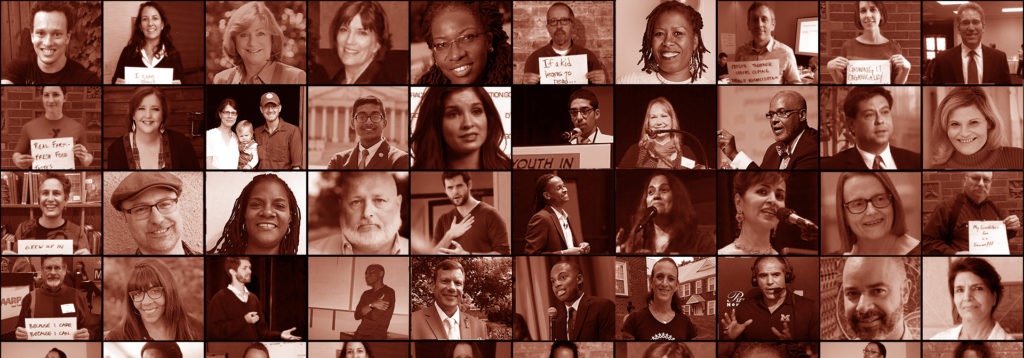
KG: I understand you have a Certification Program. Please explain.
Tim: We introduced the Living Proof Advocacy Certification Training about three years ago and, as I said, we’re really excited about it. It’s geared toward two types of individuals: independent coaches and trainers who want to add this skill to their portfolio or who are particularly interested in doing this kind of work, and to staff and volunteers of organizations who want to build internal capacity so they can offer ongoing support to their advocates. For example, we’ve recently certified three coaches for a mental health advocacy organization, four for a biopharma company’s patient advocacy team, and a number of independent coaches who are incorporating our methods into their work in really creative ways.
KG: What’s next for LPA? What are you working on currently?
John: Well, we’re very excited about the research project we’re working on with Wilder Research Foundation.
John: Practically every organization we work with, at some point or another asks, “How do we know this is working? We believe in our heart of hearts that stories communicate in a unique and powerful way. But how do we demonstrate that?” So we decided to develop some resources to help organizations answer those questions. Wilder Research first helped us review the literature out there on the relationship between personal stories and persuasion to explore how stories actually help encourage change.
Then they interviewed organizations who are doing a lot of this kind of work – preparing teams of advocate-storytellers, for example – and asked them how, and if, they measure their success. From what we’ve learned, we’re developing an evaluation toolkit for the organizations we work with, a sort of roadmap showing a few different options for evaluating their advocacy storytelling. It’s fascinating stuff.
KG: Final question…John and Tim, talk a bit about where you were born. Your upbringing. Any early influences that, in hindsight, might have led you to the successful career in personal storytelling you now have?
John: I grew up in northeastern Ohio.
Tim: I grew up in suburban Chicago.
John: Early influences? Well, in the Acknowledgments to Living Proof, we thank Mr. Ries and Ms. Seegers (Richard and Deborah Lee).
Tim: They were our junior-high and high-school speech teachers. Those early speech classes were some of the first places both of us learned to be passionate about communication and learned the importance of personal, creative expression.
John: We both were really fortunate to have schoolteachers – and then college professors – who instilled in us an appreciation of the art and craft of storytelling, of the awesome power of language, and the undeniable power of a single person’s voice.
KG: And we’ll end this interview with a blog post, written by John, that will knock your socks off! It’s a story about an amazing coincidence that happened in the course of their work. It’s a story you won’t soon forget!
CONTACT INFO:
Visit Tim and John at:
Website: www.livingproofadvocacy.com
Twitter: @livproof
Facebook: https://www.facebook.com/LivingProofAdvocacy/
Phone: 612-512-1177
NSN loves publishing items submitted by the storytelling community! If you’re interested in writing something for publication on the NSN website, newsletter, or Storytelling Magazine please contact the NSN office for more information.
Contact the National Storytelling Network
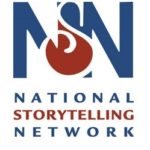 c/o Woodneath Library
c/o Woodneath Library
8900 N.E. Flintlock Road
Kansas City, MO 64157
Telephone: (800) 525-4514
Website: https://storynet.org
Email:
Find us on social media!
Facebook: https://www.facebook.com/National-Storytelling-Network-217381542906/
Twitter: https://twitter.com/NSNStorytellers
Instagram: https://www.instagram.com/nationalstorytellingnetwork
YouTube: https://www.youtube.com/channel/UCBedmDdaRi9N-4Hs-QeYNqw

